Related Research Articles
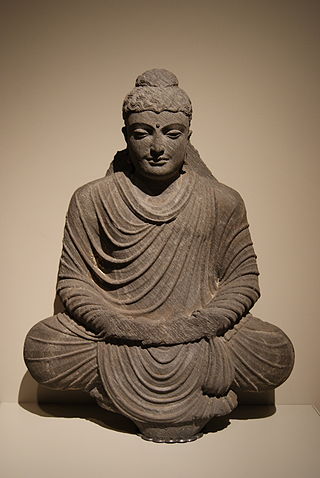
Ānāpānasati, meaning "mindfulness of breathing", paying attention to the breath. It is the quintessential form of Buddhist meditation, attributed to Gautama Buddha, and described in several suttas, most notably the Ānāpānasati Sutta.

Mahāsī Sayādaw U Sobhana was a Burmese Theravada Buddhist monk and meditation master who had a significant impact on the teaching of vipassanā (insight) meditation in the West and throughout Asia.

Buddhist meditation is the practice of meditation in Buddhism. The closest words for meditation in the classical languages of Buddhism are bhāvanā and jhāna/dhyāna.
The Vipassanā movement, also called the Insight Meditation Movement and American Vipassana movement, refers to a branch of modern Burmese Theravāda Buddhism that promotes "bare insight" (sukha-Vipassana) to attain stream entry and preserve the Buddhist teachings, which gained widespread popularity since the 1950s, and to its western derivatives which have been popularised since the 1970s, giving rise to the more dhyana-oriented mindfulness movement.

Nani Bala Barua, better known as Dipa Ma, was an Indian meditation teacher of Theravada Buddhism and was of Barua descent. She was a prominent Buddhist master in Asia and also taught in the United States where she influenced the American branch of the Vipassana movement.
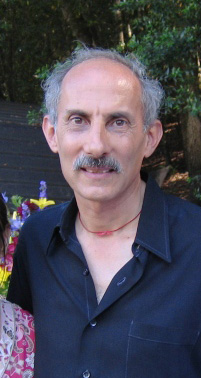
Jack Kornfield is an American writer and teacher in the Vipassana movement in American Theravada Buddhism. He trained as a Buddhist monk in Thailand, Burma and India, first as a student of the Thai forest master Ajahn Chah and Mahasi Sayadaw of Burma. He has taught mindfulness meditation worldwide since 1974. In 1975, he co-founded the Insight Meditation Society in Barre, Massachusetts, with Sharon Salzberg and Joseph Goldstein, and subsequently in 1987, Spirit Rock Meditation Center in Woodacre, California. Kornfield has worked as a peacemaker and activist, organized teacher training, and led international gatherings of Buddhist teachers including the Dalai Lama.
Sati, literally "memory" or "retention", commonly translated as mindfulness, "to remember to observe," is an essential part of Buddhist practice. It has the related meanings of calling to mind the wholesome dhammas such as the four establishments of mindfulness, the five faculties, the five powers, the seven awakening-factors, the Noble Eightfold Path, and the attainment of insight, and the actual practice of maintaining a lucid awareness of the dhammas of bodily and mental phenomena, in order to counter the arising of unwholesome states, and to develop wholesome states. It is the first factor of the Seven Factors of Enlightenment. "Correct" or "right" mindfulness is the seventh element of the Noble Eightfold Path.

Sharon Salzberg is an author and teacher of Buddhist meditation practices in the West. In 1974, she co-founded the Insight Meditation Society at Barre, Massachusetts, with Jack Kornfield and Joseph Goldstein. Her emphasis is on vipassanā (insight) and mettā (loving-kindness) methods, and has been leading meditation retreats around the world for over three decades. All of these methods have their origins in the Theravada Buddhist tradition. Her books include Lovingkindness: The Revolutionary Art of Happiness (1995), A Heart as Wide as the World (1999), Real Happiness - The Power of Meditation: A 28-Day Program (2010), which was on The New York Times Best Seller list in 2011, and the follow-up Real Happiness at Work (2013). She runs a Metta Hour podcast, and contributes monthly to a column On Being.
Gil Fronsdal is a Norwegian-born, American Buddhist teacher, writer and scholar based in Redwood City, California. He has been practicing Buddhism of the Sōtō Zen and Vipassanā sects since 1975, and is currently teaching the practice of Buddhism in the San Francisco Bay Area. Having been taught by the Vipassanā practitioner Jack Kornfield, Fronsdal is part of the Vipassanā teachers' collective at Spirit Rock Meditation Center. He was ordained as a Sōtō Zen priest at the San Francisco Zen Center in 1982, and was a Theravāda monk in Burma in 1985. In 1995, he received Dharma transmission from Mel Weitsman, the abbot of the Berkeley Zen Center.
The Ānāpānasati Sutta (Pāli) or Ānāpānasmṛti Sūtra (Sanskrit), "Breath-Mindfulness Discourse," Majjhima Nikaya 118, is a discourse that details the Buddha's instruction on using awareness of the breath (anapana) as an initial focus for meditation.
The Satipaṭṭhāna Sutta, and the subsequently created Mahāsatipaṭṭhāna Sutta, are two of the most celebrated and widely studied discourses in the Pāli Canon of Theravada Buddhism, acting as the foundation for contemporary vipassana meditation practice. The Pāli texts of the Satipaṭṭhāna Sutta and the Mahāsatipaṭṭhāna Sutta are largely similar in content; the main difference being a section about the Four Noble Truths in the Observation of Phenomena (Dhammānupassana), which is greatly expanded in the Mahāsatipaṭṭhāna Sutta. These suttas (discourses) stress the practice of sati (mindfulness) "for the purification of beings, for the overcoming of sorrow and lamentation, for the extinguishing of suffering and grief, for walking on the path of truth, for the realization of nibbāna."
Joseph Goldstein is one of the first American vipassana teachers, co-founder of the Insight Meditation Society (IMS) with Jack Kornfield and Sharon Salzberg, a contemporary author of numerous popular books on Buddhism, a resident guiding teacher at IMS, and a leader of retreats worldwide on insight (vipassana) and lovingkindness (metta) meditation.
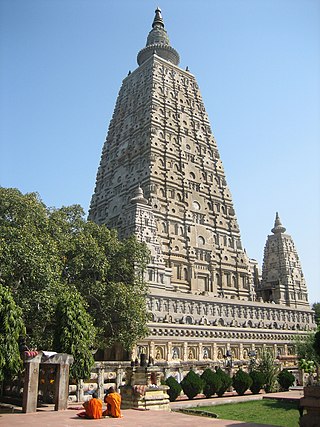
Anagarika Shri Munindra, also called Munindraji by his disciples, was an Indian Vipassanā meditation teacher, who taught many notable meditation teachers including Dipa Ma, Joseph Goldstein, Sharon Salzberg, and Surya Das. Anagarika simply means a practicing Buddhist who leads a nomadic life without attachment in order to focus on the Dhamma.
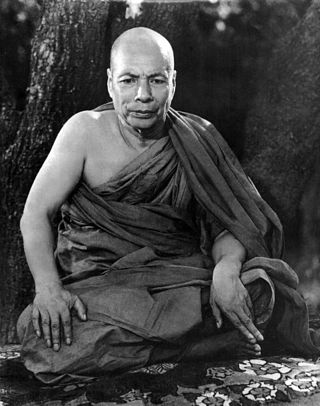
U Vimala, commonly known as the Mogok Sayadaw, was a renowned bhikkhu and vipassanā meditation master of Theravada Buddhism.
Samatha, "calm," "serenity," "tranquility of awareness," and vipassanā, literally "special, super, seeing ", are two qualities of the mind developed in tandem in Buddhist practice.
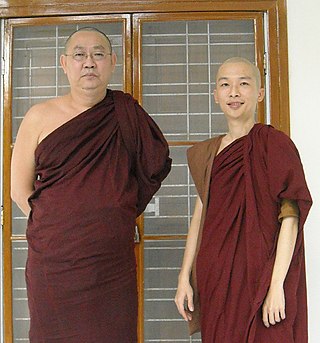
Sayadaw U Tejaniya is a Theravādin Buddhist monk of Chinese descent and the meditation teacher at the Shwe Oo Min Dhamma Sukha Forest Center in Yangon, Myanmar whose teachings have attracted a global audience.

Bhante Vimalaraṁsi was an American Buddhist monk and Abbot of the Dhamma Sukha Meditation Center in Annapolis, Missouri.
Sunlun Sayadaw, was a Burmese Sayadaw and vipassanā meditation master of Theravada Buddhism. He was named for Sunlun village, which is near Myingyan, middle Burma.

Mindful Yoga or Mindfulness Yoga combines Buddhist-style mindfulness practice with yoga as exercise to provide a means of exercise that is also meditative and useful for reducing stress. Buddhism and Hinduism have since ancient times shared many aspects of philosophy and practice including mindfulness, understanding the suffering caused by an erroneous view of reality, and using concentrated and meditative states to address such suffering.
Frank Jude Boccio is a teacher and one of the originators of mindful yoga. He is known both for his teaching in centres across America, and for his 2004 book Mindfulness Yoga: The Awakened Union of Breath, Body and Mind, which describes a practice that combines yoga as exercise and Buddhist meditational practice.
References
- ↑ Thumma, Scott; Gray, Edward R. (2004). Gay Religion. Rowman Altamira. p. 146. ISBN 9780759115064 . Retrieved 29 November 2014.
- ↑ "Larry Rosenberg". Shambhala Publications . Retrieved 2016-05-24.
- ↑ Tricycle (2019-08-08). "Larry Rosenberg and The Art of Doing Nothing". Tricycle.org. Retrieved 2019-12-28.
- ↑ Knaster, Mirka (12 October 2010). Living This Life Fully: Stories and Teachings of Munindra – Mirka Knaster – Google Books. Shambhala Publications. ISBN 9780834822542 . Retrieved 2019-12-28.
- ↑ Thumma, Scott; Gray, Edward R. (10 December 2004). Gay Religion. Rowman Altamira. ISBN 9780759115064 . Retrieved 2019-12-28.